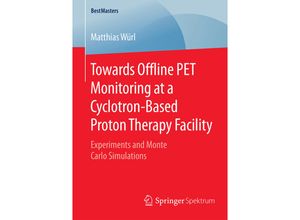Matthias Würl presents two essential steps to implement offline PET monitoring of proton dose
delivery at a clinical facility namely the setting up of an accurate Monte Carlo model of the
clinical beamline and the experimental validation of positron emitter production
cross-sections. In the first part the field size dependence of the dose output is described
for scanned proton beams. Both the Monte Carlo and an analytical computational beam model were
able to accurately predict target dose while the latter tends to overestimate dose in normal
tissue. In the second part the author presents PET measurements of different phantom materials
which were activated by the proton beam. The results indicate that for an irradiation with a
high number of protons for the sake of good statistics dead time losses of the PET scanner may
become important and lead to an underestimation of positron-emitter production yields.



